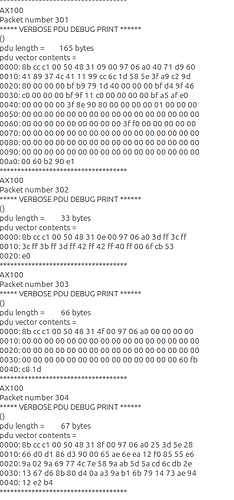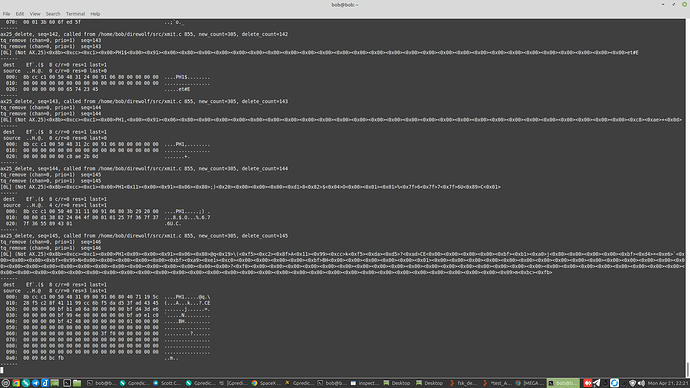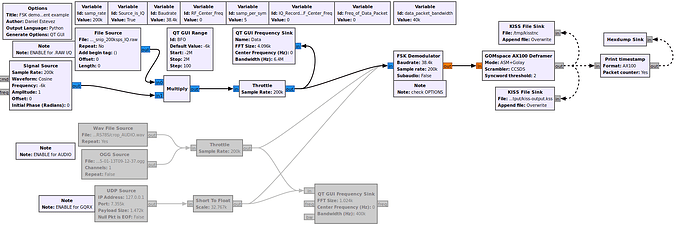yeah, I’m uploading the IQ to a google drive folder, but it will take at least a couple of hours, big file and Internet here is soooooo slow…
https://drive.google.com/drive/folders/1W0DEzJwpELb7A5Qtr3OfwCAgYUtW8T1b?usp=sharing
that’s the link to the folder (empty now as the file is still uploading), check the folder in a couple of hours and let me know.
no QRM from ISM devices in 433.920? you are so lucky!!!
Awesome, thank you!
Thank you!
Nice looking signals. Did you EMP your neighbors?
i’m still baffled and in total disbelief of 433.92 clear, it’s so beautiful. mind blowing
Phoenix-1 decoded as 38K4 AX100 (GOMSpace AX100 asm + golay deframer); note PH1 in Direwolf decodes.
Links to uploaded files are below
73 es good hunting all
Bob
N6RFM
The team is now getting into analysis phase, any observation/IQ files etc can be useful to them. Please make sure as much as possible to also include timestamps (in UTC) when you share your data, that will be very helpful to get everything in time order. ![]()
Great job as always, Bob!!
I live in a small town ![]() (we have few devices ISM around here)
(we have few devices ISM around here)
If anyone using GNU Radio would like a starting point as to the blocks & settings to use, this flowgraph decodes Bob’s PH-1 packets nicely. (I’ve only tested w/ a source being the I/Q file… an audio recording would only work if the RX audio bandwidth was sufficient for 38k4 baud!)
Files are here
IQ collected using beam
IQ collected using helix
Snippet from helix IQ for convenience
kss file from entire pass based on IQ collected using helix
over 1675 frames decoded.
pls share with the team as appropriate.
73,
Bob
N6RFM/5 EM12jw
Really awesome Bob,
Thanks for sharing this information.
Jan | PE0SAT
Always a pleasure to help my friends and mentors Jan!! Thanks heads up earlier!
![]()
HERE is the link to the Drive (All recordings made with 1.024MSPS)
The time the files were recorded is in BRT (UTC-3)
It is pretty early on this side of the globe and I am already enjoying a very big smile, what a community.
With the knowledge from Scott and Bob we now know that the IQ can be decoded, for the Windows users try the UZ7HO BOBCAT version. This is already a couple of years old but should still work.
Keep in mind that 38k4 is to wide for your default Windows audio device, 44.1 or even 48 won’t be enough, you will have to change this.
Thank you all.
Congrats on your captures!
It’s getting late here, but I ran your first recording through GNU Radio.
Here is just a partial output of the decodes. Great job!
pu4elt_PH1_partial_23-48-42_decodes.txt (25.9 KB)
Here is a link to an article made by JE9PEL on decoding high speed AX.100 frames on Windows.
Jan | PE0SAT
Ohh TNX Scott !!! Amazing job. Later I will try to generate something with GNU and test the UZ7HO BOBCAT shared here by @PE0SAT
I have to sleep ![]()
![]() it’s 01:44AM here in Brazil
it’s 01:44AM here in Brazil
For the gr-satellites cli users this Yaml file can be used with the IQ recordings.
gr_satellites PHOENIX-ONE.yml --rawfile Phoenix1_helix_200000SPS_434000000Hz_2025_04_22_T023218Z_snippet.iq --samp_rate 200000 --iq
name: PHOENIX-ONE
norad: 98608
data:
&tlm Telemetry:
unknown
&csp csp Telemetry:
telemetry: csp
transmitters:
38k4 FSK downlink:
frequency: 434.000e+6
modulation: FSK
baudrate: 38400
framing: AX100 ASM+Golay
data:
- *csp
Producing the following csp frames, one can clearly see the PH10 value.
-> Packet from 38k4 FSK downlink
Container:
header = Container:
priority = 2
source = 5
destination = 28
destination_port = 51
source_port = 1
reserved = 0
fragmentation = False
hmac = False
xtea = False
rdp = False
crc = False
payload = b'PH1O\x00\x93\x06\xa0\x00\x00\x00\x00\x00\x00\x00\x00\x00\x00\x00\x00\x00\x00\x00\x00\x00\x00\x00\x00\x00\x00\x00\x00\x00\x00\x00\x00\x00\x00\x00\x00\x00\x00\x00\x00\x00\x00\x00\x00\x00\x00\x00\x00\x00\x00\x00\x00\x00\x00J\xf8\x9e\xa6' (total 62)



